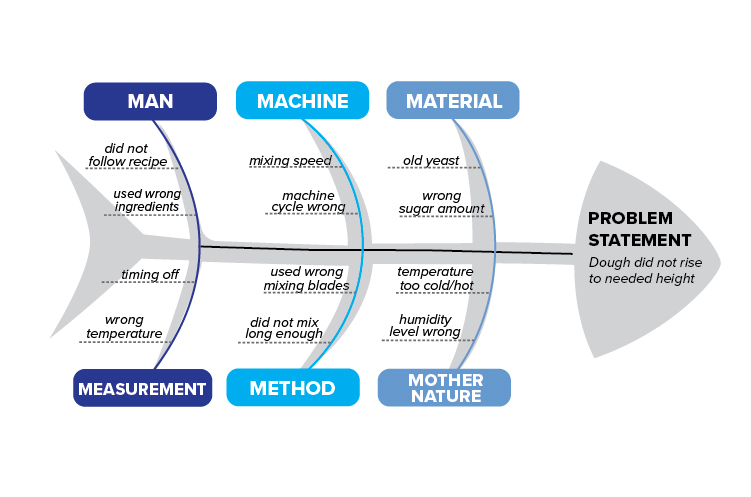How to Create a Fishbone Diagram

Use this worksheet, and start to create your own Fishbone Diagram for problem solving.
- Draw a horizontal line from left to right.
- Draw a “fish head” at the right end of the line (you can use a circle or box). This is where your problem statement will go.
- Draw three, equally spaced lines angling upward and backward from the horizontal line.
- Draw three equally spaced lines angling downward and backward below the line
- Draw a box on each end of the angled lines.
- Write one of the 6 main causes of problems in manufacturing in each box:
- Man (people)
- Machine (equipment)
- Material
- Method (process)
- Mother Nature (environment)
- Measurement
Creating a Problem Statement
Now that you have finished your basic fishbone diagram, your cross-functional team needs to be create a specific problem statement that everyone understands and can agree on in order to work toward a solution that will eliminate the root cause of the problem.
Let’s go back to our bakery example. If the problem statement states, “bread doesn’t look right” or “bread didn’t rise,” you have not defined the problem correctly and your solutions might not identify the correct root cause. The real problem was that the dough did not rise to the needed height before being placed in the oven. Identifying and defining the problem as specifically as a possible is a critical part of identifying the root cause and developing a permanent solution.
Now, write your problem statement into the fish’s head (to the right side).
Determining the Root Cause
Your next step is to brainstorm for potential root causes. Start asking questions for each category on what could have been a contributing factor for the dough not rising to the needed height.
An example would be: What impact could “Man” (people) have had that the dough did not to rise to the needed height? Write that answer on a line in the “Man” cause section.
Continue to do this for each of the causes until you have exhausted all the options and developed a list of causes. You might not have an equal number of answers under each category. That is OK.
Once you have exhausted asking what could have contributed to the problem in each category, your fishbone diagram should like the one pictured above.
Sometimes it is a good practice to stop after a while or reschedule the process for another day before reviewing all listed causes. Often additional items come up or some items might be contributing factors in more than one category.
Next ask, “why could each factor have caused the dough not to rise to the needed height?” Every time you get an answer, continue to ask another “why.”
An example would be “why did the incorrect amount of sugar stop the yeast from rising?”
The answer is, “The amount of sugar was insufficient to allow the yeast to produce enough CO2 and create enough bubbles to help the dough rise.”
A mistake often made is to stop asking “why” too soon and to focus on one item that seems the most obvious cause. You need to exhaust all potential causes in order to uncover the root cause or causes and then determine which root cause to address first.
You can use a variety of ways to decide which root cause to solve first. One way is to have a vote and decide by majority. Another way is to give each team member a set number of votes and let them assign any combination of votes, from one to all, to what they think is the most important root cause to address. Because managers, supervisors, or other leaders on the team might influence some people on how to vote, it’s best to use a secret ballot.
The key here is that you want to tap into everyone’s ideas, insights, and feedback, rather than a top-down decision. Carefully considering everyone’s input will greatly increase the chance of identifying and solving the root cause. The success of identifying the root cause and developing a permanent fix depends on a true team effort and is a great example of lean manufacturing and the empowerment of everyone.
Finally, even the best analysis may not identify the true root cause. Therefore, keep the fishbone diagram and all the information as your documentation in case the same issues should reoccur later. See if you can identify additional causes or just pick the next root cause on the list and implement a fix for it.
With the input of your cross-functional team guiding the analysis, a fishbone diagram can be a guide to effective and lasting problem-solving.
An insurance company that cares about you and insuring the things you wish to be insured.
Get a Quote> Find an Agent>

